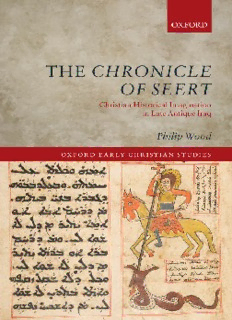
Christian Historical Imagination in Late Antique Iraq PDF
Preview Christian Historical Imagination in Late Antique Iraq
OXFORD EARLY CHRISTIAN STUDIES General Editors Gillian Clark Andrew Louth THEOXFORDEARLYCHRISTIANSTUDIESseriesincludesscholarlyvolumeson the thought and history of the early Christian centuries. Covering a wide range of Greek, Latin, and Oriental sources, the books are of interest to theologians, ancient historians,andspecialistsintheclassicalandJewishworlds. Titlesintheseriesinclude: BasilofCaesarea,GregoryofNyssa,andthe TransformationofDivineSimplicity AndrewRadde-Gallwitz(2009) TheAsceticismofIsaacofNineveh PatrikHagman(2010) PalladiusofHelenopolis TheOrigenistAdvocate DemetriosS.Katos(2011) OrigenandScripture TheContoursoftheExegeticalLife PeterMartens(2012) ActivityandParticipationinLateAntiqueandEarlyChristianThought TorsteinTheodorTollefsen(2012) IrenaeusofLyonsandtheTheologyoftheHolySpirit AnthonyBriggman(2012) ApophasisandPseudonymityinDionysiustheAreopagite “NoLongerI” CharlesM.Stang(2012) MemoryinAugustine’sTheologicalAnthropology PaigeE.Hochschild(2012) OrosiusandtheRhetoricofHistory PeterVanNuffelen(2012) DramaoftheDivineEconomy CreatorandCreationinEarlyChristianTheologyandPiety PaulM.Blowers(2012) EmbodimentandVirtueinGregoryofNyssa HansBoersma(2013) The Chronicle of Seert Christian Historical Imagination in Late Antique Iraq PHILIP WOOD 1 3 GreatClarendonStreet,Oxford,OX26DP, UnitedKingdom OxfordUniversityPressisadepartmentoftheUniversityofOxford. ItfurtherstheUniversity’sobjectiveofexcellenceinresearch,scholarship, andeducationbypublishingworldwide.Oxfordisaregisteredtrademarkof OxfordUniversityPressintheUKandincertainothercountries #PhilipWood2013 Themoralrightsoftheauthorhavebeenasserted FirstEditionpublishedin2013 Impression:1 Allrightsreserved.Nopartofthispublicationmaybereproduced,storedin aretrievalsystem,ortransmitted,inanyformorbyanymeans,withoutthe priorpermissioninwritingofOxfordUniversityPress,orasexpresslypermitted bylaw,bylicenceorundertermsagreedwiththeappropriatereprographics rightsorganization.Enquiriesconcerningreproductionoutsidethescopeofthe aboveshouldbesenttotheRightsDepartment,OxfordUniversityPress,atthe addressabove Youmustnotcirculatethisworkinanyotherform andyoumustimposethissameconditiononanyacquirer BritishLibraryCataloguinginPublicationData Dataavailable ISBN 978–0–19–967067–3 PrintedandboundinGreatBritainby CPIGroup(UK)Ltd,Croydon,CR04YY Contents Preface ix NotesonTransliterationandTerminology xi Map xii Abbreviations xiii Introduction 1 TheChronicleofSeert 2 ApproachingtheChronicle 4 TrustingtheChronicle 6 TheTextureoftheChronicle 9 StructuresoftheSasanianState 13 ReligionandtheSasanianState 19 GeographyofaChristianMinority 22 Babylonia 23 Khuzistan 25 Assyria 26 1. CollaboratorsandDissidents:WritingtheHagiographies oftheFifth-centuryPersecutions 31 The410SynodofSeleucia-Ctesiphon 32 TheWarof421andtheNewPersecutions 37 TheMartyrsofYazdegardandVahram 39 Abgar’sCycle:LoyaltyandPersecution 44 TheVandalsRemembered 48 Conclusions 50 2. TheMartyrsandtheCatholicos:TheActsoftheSymeonand TheirReinvention 52 TheRelicCultandtheInventionofHistory 52 SymeonbarSebbaʿe:MartyrforaChristianPeople 55 DevelopingtheActsofSymeon:AuthorityandtheCatholicos 57 TheActsofSymeonandtheControlofHistory 60 Conclusions 64 3. ThePatriarchalHistories:GenesisofaCentralizingNarrative 66 TheMedievalCompilations:BarHebraeus,Mari,andʿAmr 67 TheMedievalCompilations:TheChronicleofSeertand theHaddadChronicle 70 Acacius’History 71 vi Contents TheFifthCenturyintheAcacianHistory 74 TheSchoolofʿAbda 75 MilesandPapas:TheCouncilofDadishoʿ 78 MilesandPapas:TheReconstructionsoftheHistories 84 PapasandDemetrianus:HistoriesofExileand theRightsofGundishapur 87 Conclusions 91 4. TheChurchandtheWorld 93 ClericalReform:AcaciusandBarsauma 95 ClericalReform:Narsai,Elishe,andtheHistoryofaCrisis 100 TheSchoolofNisibis:Barsauma,Acacius,andChristology 106 TheSchoolofNisibis:NisibeneTheologyinCtesiphon 108 TheChurchandtheShahs:SeekingFavour 112 Conclusions 118 5. RomanEcclesiasticalHistoryintheSasanianWorld:Reception, Adaptation,andReaction 120 TheExpansioninHistory-writing 121 TheIdentityoftheEcclesiasticalHistorians 122 ANewRomanPast 124 TheDyophysiteFathersandtheReceptionoftheFifth-century Histories 125 IshoʿyahbIandtheIncorporationofRomanEcclesiasticalHistory 128 NisibisandtheDyophysiteHistoryofBarhadbeshaba 131 ChalcedonintheChurchoftheEast 134 TheAnti-ChalcedonTradition 135 ANestorianChurch 140 Conclusions 142 6. BeyondCtesiphon:MonasteriesandAristocrats intheChristianHistories 143 AbrahamicMonasticismatIzla 146 MonasticismaftertheHenanianCrisis 149 TheHagiographicCollections:TheBookofChastity 150 TheBookoftheGovernors 153 AuthorityandConflictintheAccountsofBabaitheGreat 156 MonasticHagiographyintheChronicleofSeert:TheCatholicoi andtheJacobites 160 MonasticFoundationsandIranianAristocracy 163 LocalHagiographiesandIranianPatrons 166 IranianHistoriesandChristianAuthors:TheActsof MarQardagh 169 IranianHistoriesintheChronicleofSeert 171 Conclusions 174 Contents vii 7. TheLastGreatWarofAntiquity:TheReactionofChristianIraq 176 TheGreatWarbetweenRomeandPersia 177 HistoriographyoftheGreatWar 181 NarrativeFamiliesintheHistoryoftheGreatWar 184 KhusrauandtheChristians 188 TheLifeofSabrishoʿ 189 NuʿmanandSabrishoʿ 192 TheElectionofSabrishoʿ 194 ChristiansinaTimeofWar:TheInvasionofDara 196 ChristiansinaTimeofWar:KhusrauandtheMiaphysites 199 GregoryofNisibis 202 GregoryandtheSackofNisibis 204 TheElectionofGregoryofPherat(605–9) 206 RivalsandSuccessors:ChristianPoliticalIdeasafter612 210 TheFallofJerusalemintheKhuzistanChronicle 211 TheFallofJerusaleminAntiochosStrategos 213 TheMurderofKhusrau 215 TheReignofShahrbaraz 218 Conclusions 219 8. TheChurchofBaghdad:ANewPastforChristianIraq 221 AnIndianSummer 222 TheCatholicoiandtheArabs 224 WritingChristianHistoryunderArabRule 229 TalesofConstantine 232 AnExpandingChurch 236 ANewHistoryofMonasticism:TheNestoriansintheWest 241 RememberingMuhammad:TaxationandNarrativesofSurrender 243 RememberingMuhammad:TheHistoriesofNajran 249 RememberingMuhammad:Christians,Jews,andMuslims 253 Conclusions 255 Conclusions 257 EpiscopalandRegnalLists 262 SynodsoftheChurchoftheEast 265 History-writingintheChurchoftheEast 266 ContentsoftheChronicleofSeert 268 Bibliography 274 Index 299 This page intentionally left blank Preface ThisstudyoftheChronicleofSeertgrewoutaseriesofintereststhatdeveloped while researching my doctorate. While my DPhil was concerned with the eastern Roman Empire, my eyes were increasingly drawn across the frontier, to the reception of the ideas, narratives, and institutional structures of the easternRomanworldintheSasanianEmpire.TheChronicleofSeertstoodout inparticularasatextthatscholarssometimesmentionedinpassing,butnever treatedasawhole,letalonesituatingitintoitsSasanianandAbbasidcontexts. My study of the Chronicle was aided by the opportunity to use a closely relatedtext,theMukhtasaral-’akhbāral-biʿīya.ThiswasdiscoveredbyFather ˙ Butrus Haddad in Baghdad immediately before the second Iraq war, and students of Iraqi history should be most indebted to him for bringing this texttothelightofday.FollowingthecustomofcallingtheKhuzistanChronicle afteritsdiscoverer,IgnazioGuidi,IhaveusedthetermHaddadChronicle,as a shorthand reference. In addition, I am personally very grateful to Robert Hoylandforallowingmetophotocopyhiscopyofthechronicle. I was very fortunate to be funded by a British Academy postdoctoral fellowship, which allowed me time to work on this project. I am also very gratefultoCorpusChristiCollege,Oxford,forprovidingsuchawonderfulbase for my Junior Research Fellowship and for the membership of the Corpus Classicscentre.Theywereveryhappyyears.Myfellowshipalsoallowedmeto startworkonArabic,whichIpursuedinDamascus,andtospendtimeintheSyrian orthodoxpatriarchalmonasteryatMaʿaratSeidnaya.Thebookwascompletedat SidneySussexCollege,Cambridge,towhomIalsooweadebtofgratitude. I have accumulated a great many debts in the course of this project. My very great thanks go to Averil Cameron, my doctoral supervisor, who read the whole text in draft and made many highly pertinent observations. James Howard-Johnston was my British Academy mentor for the fellowship and was assiduous in offering advice on the text and urging me to remember the geography of my subject. David Taylor has been helpful and humorous in equalmeasure,andguidedmeoutofseveralpitfalls,andMazanRabiʿataught me Arabic for several summers, sitting under the fig tree in his garden in Damascus:bothhavethepatienceofsaints. My thanks also goes to Richard Payne and Elizabeth Campbell, who were travelling companions for trips to Iran, Iraq, and Turkey and offered much valuable advice. Imust alsothankthevarious poorsouls whoIpersuaded to readsectionsofthetextinvariousstagesofpreparation,especiallyRosamond McKitterick,DanielHadas,HarryMunt,PhilBooth,AdamBecker,Khodadad
Description: